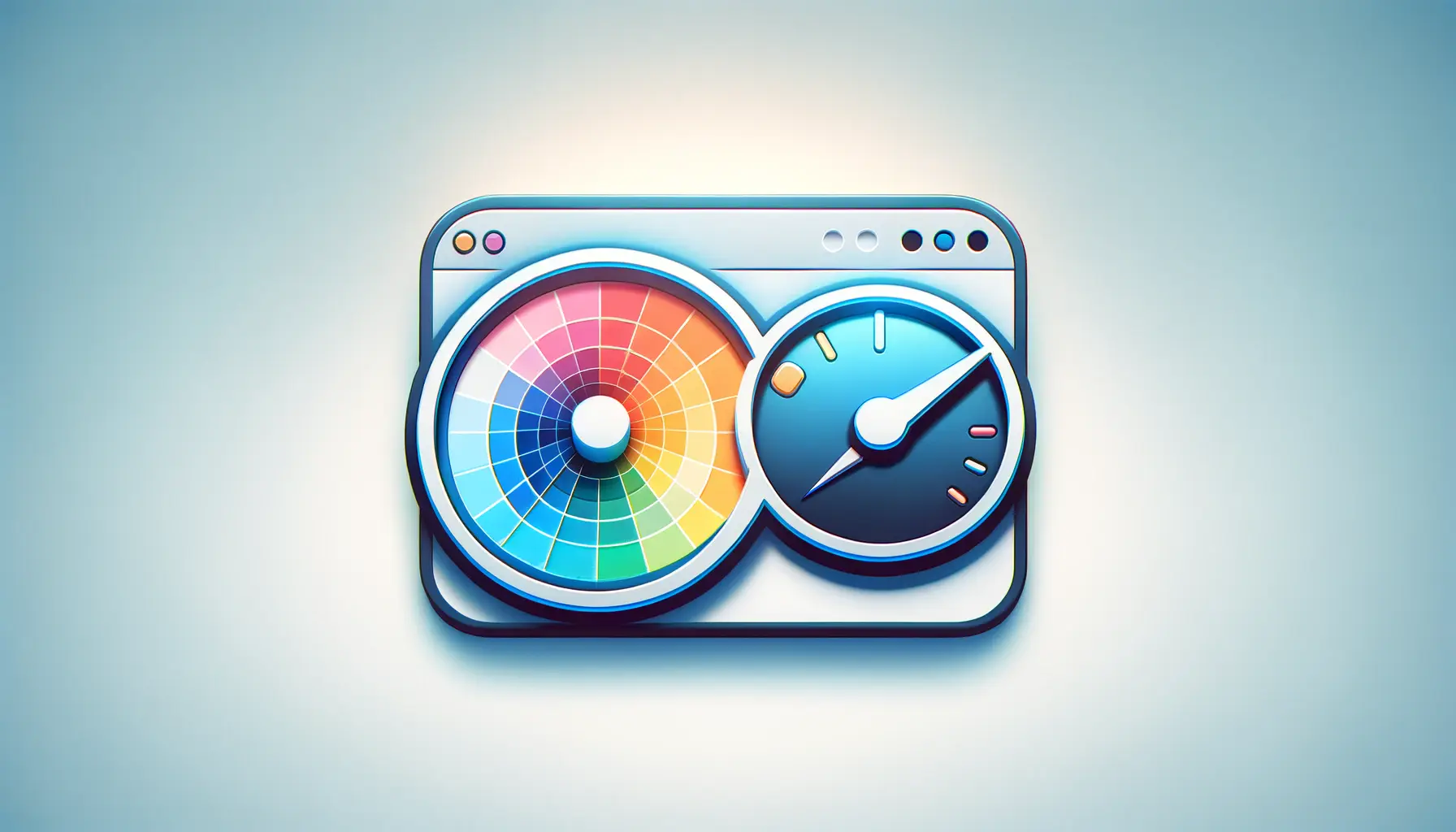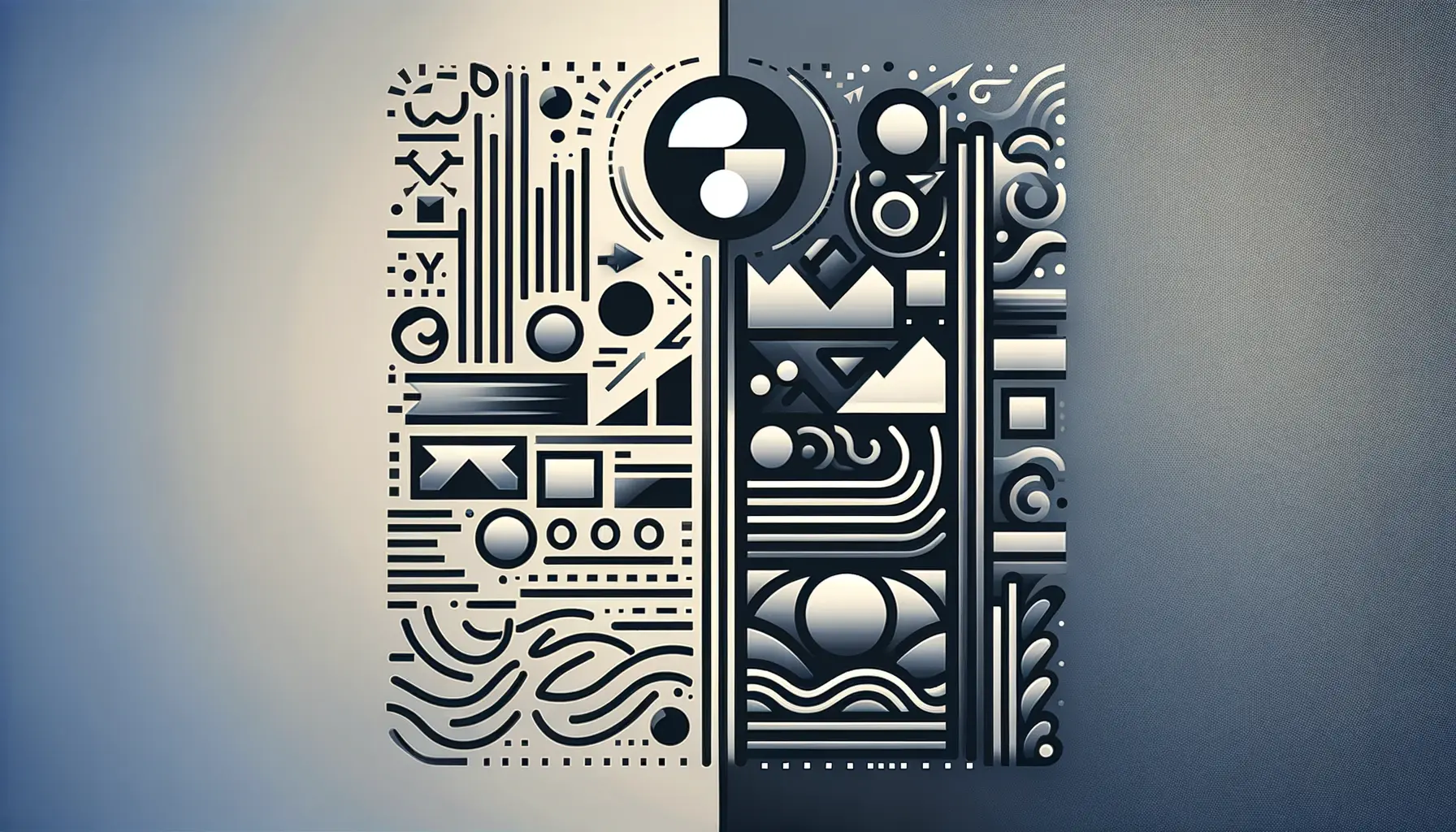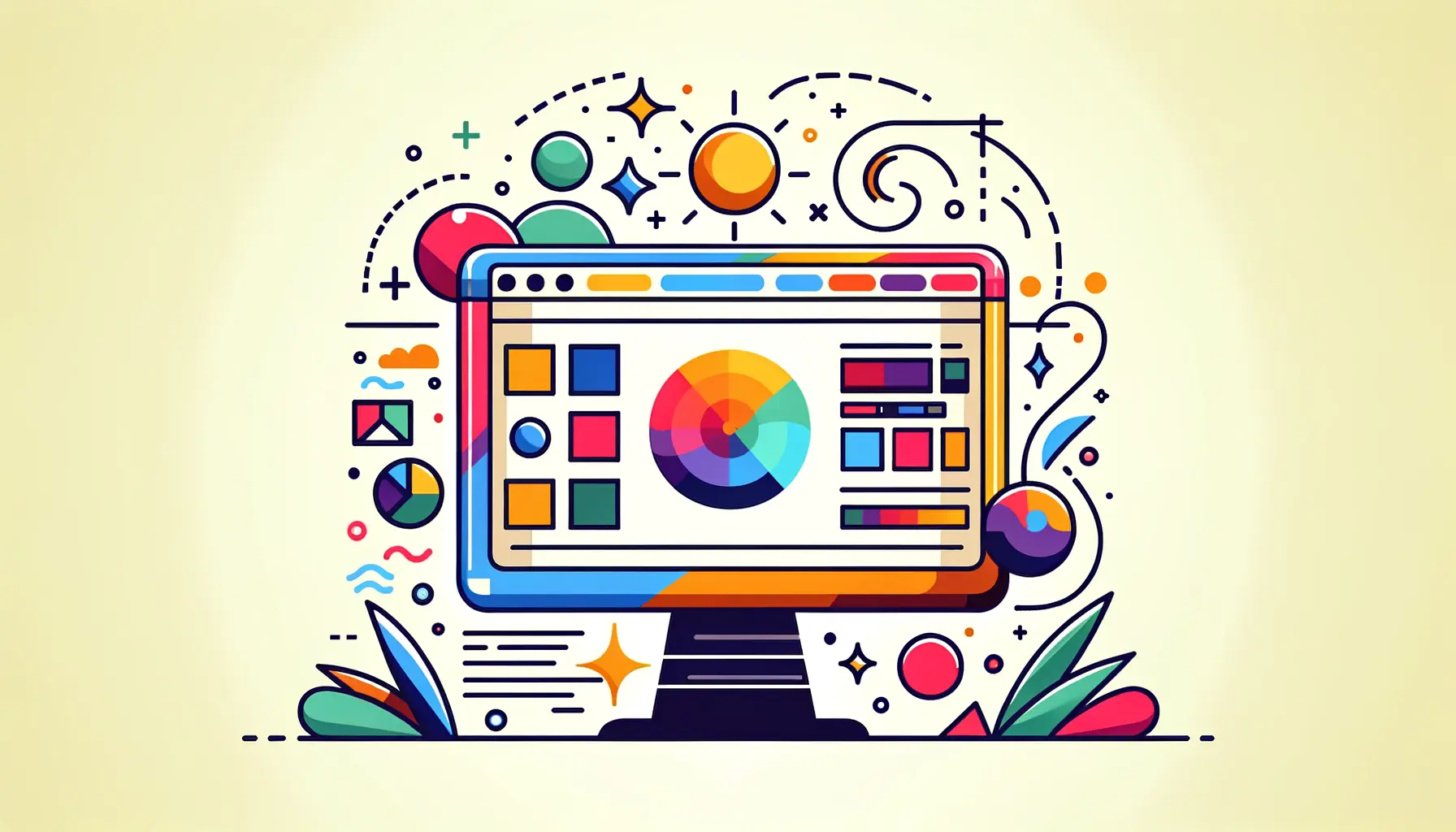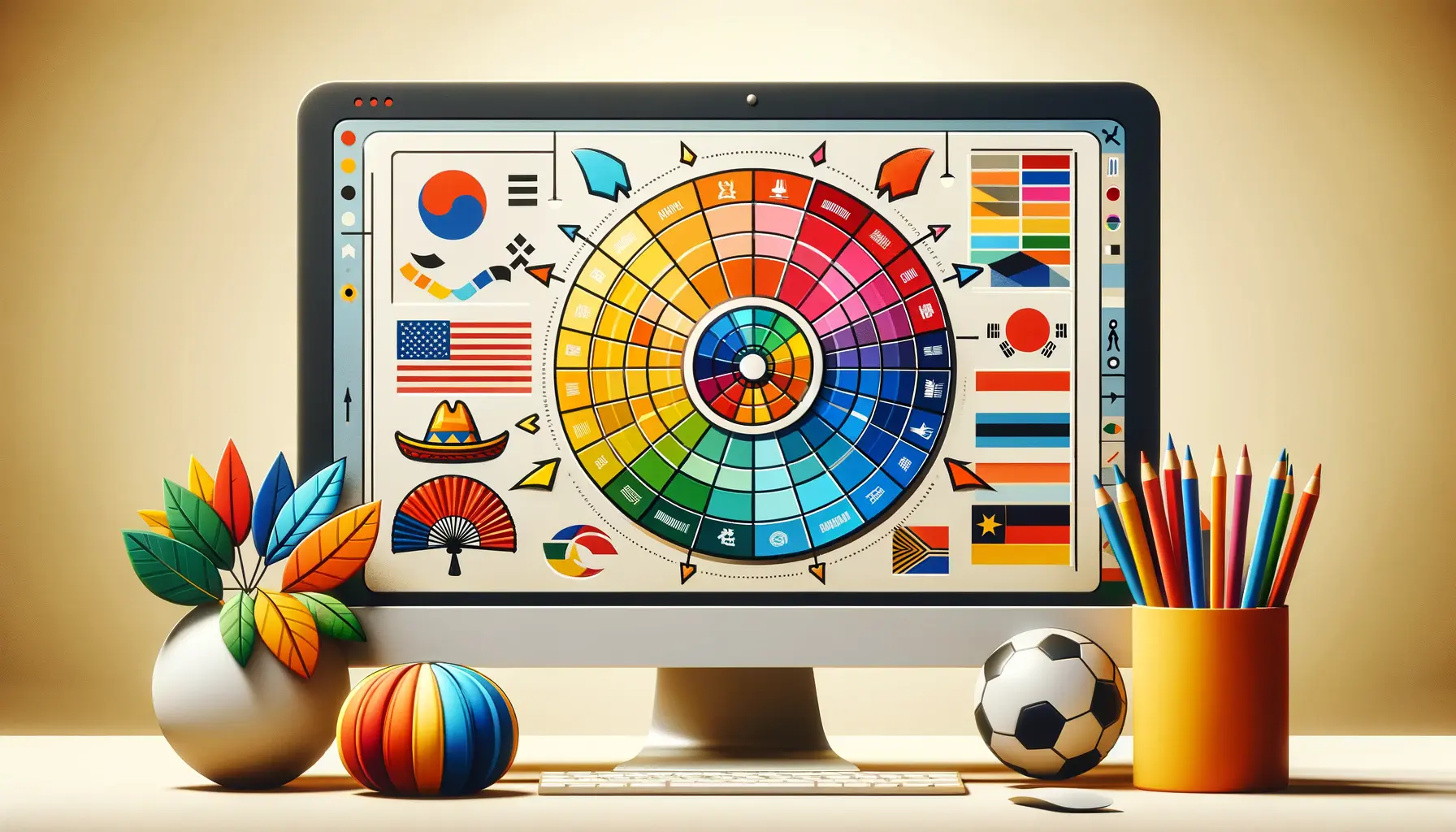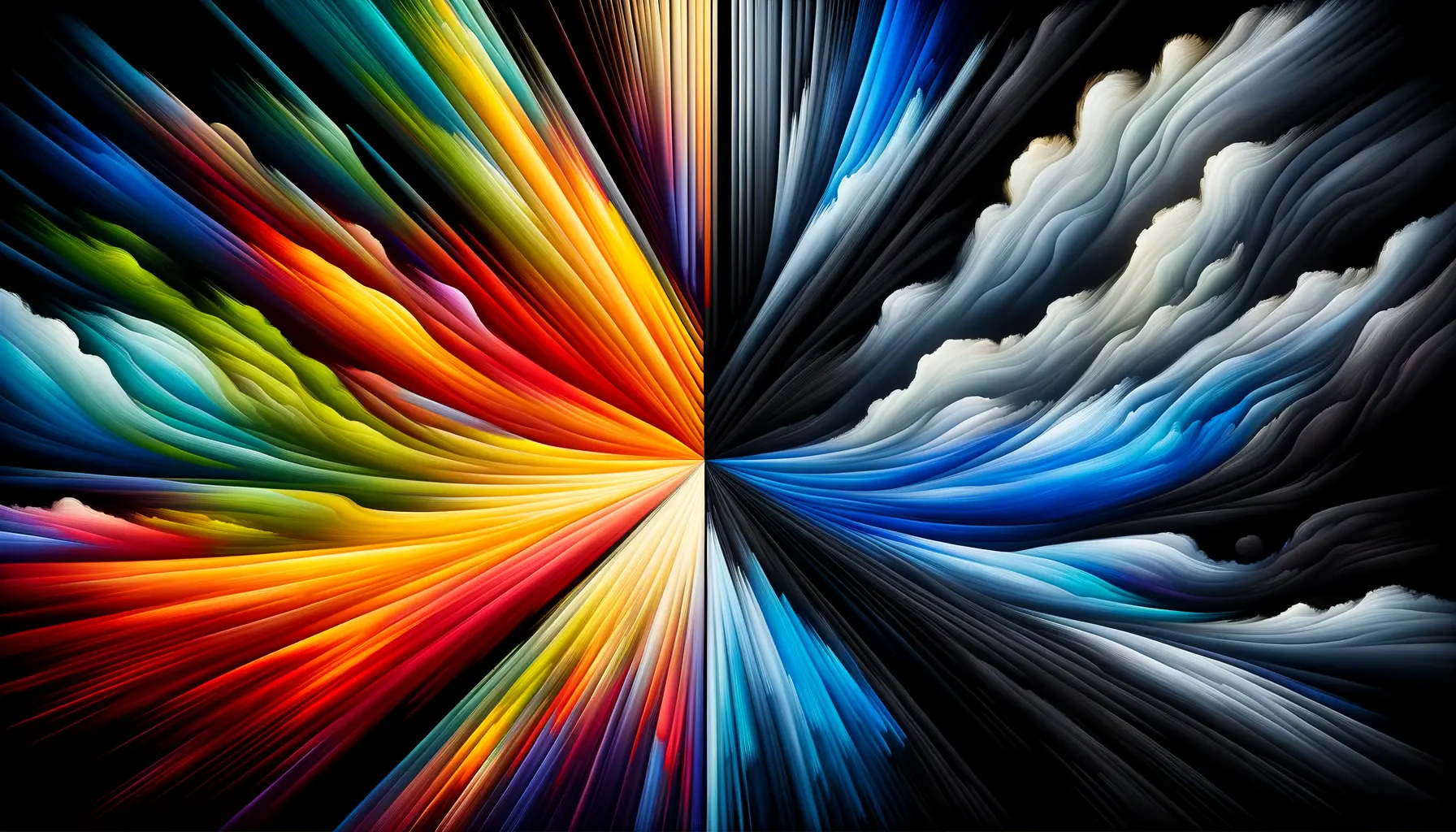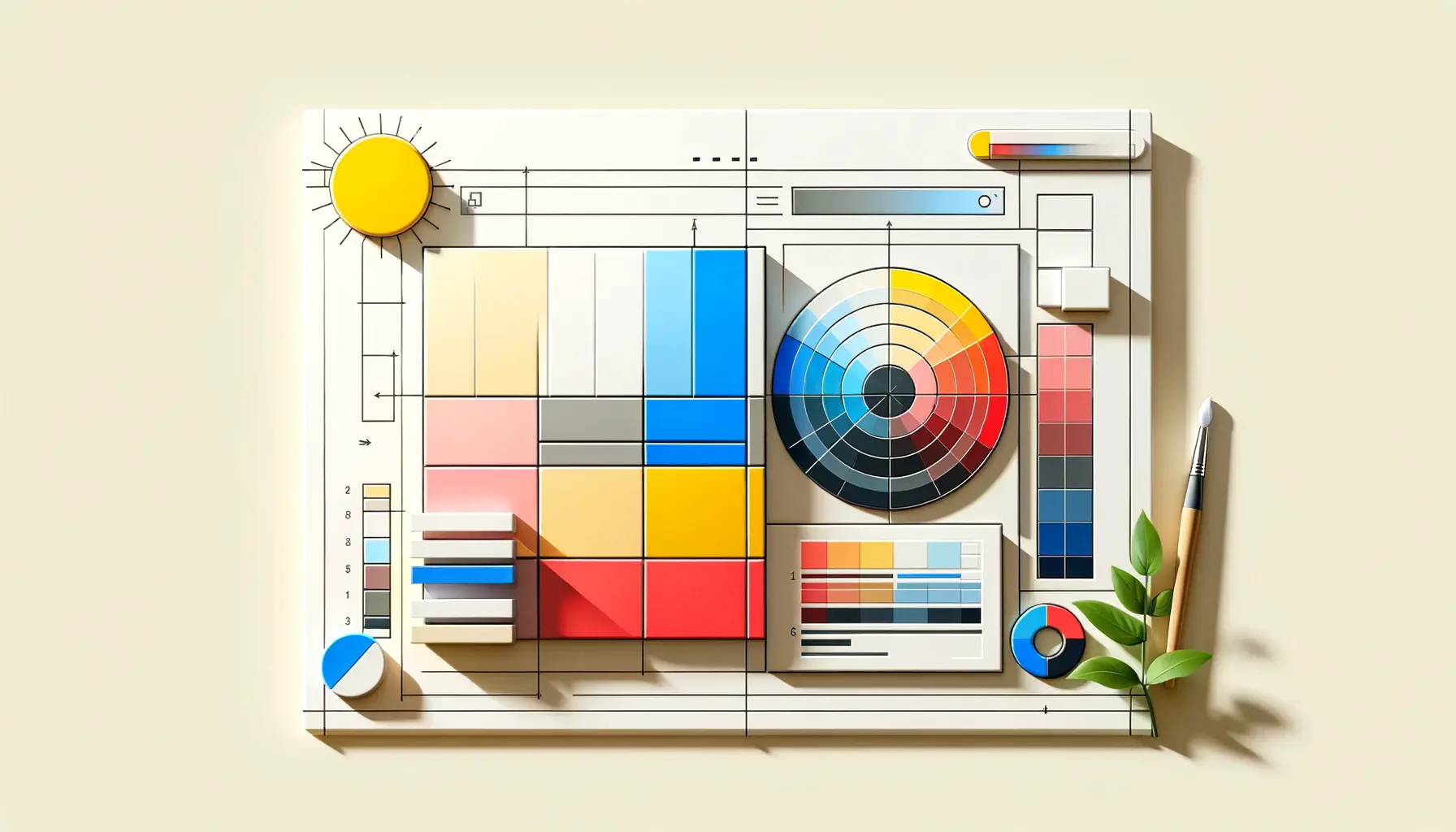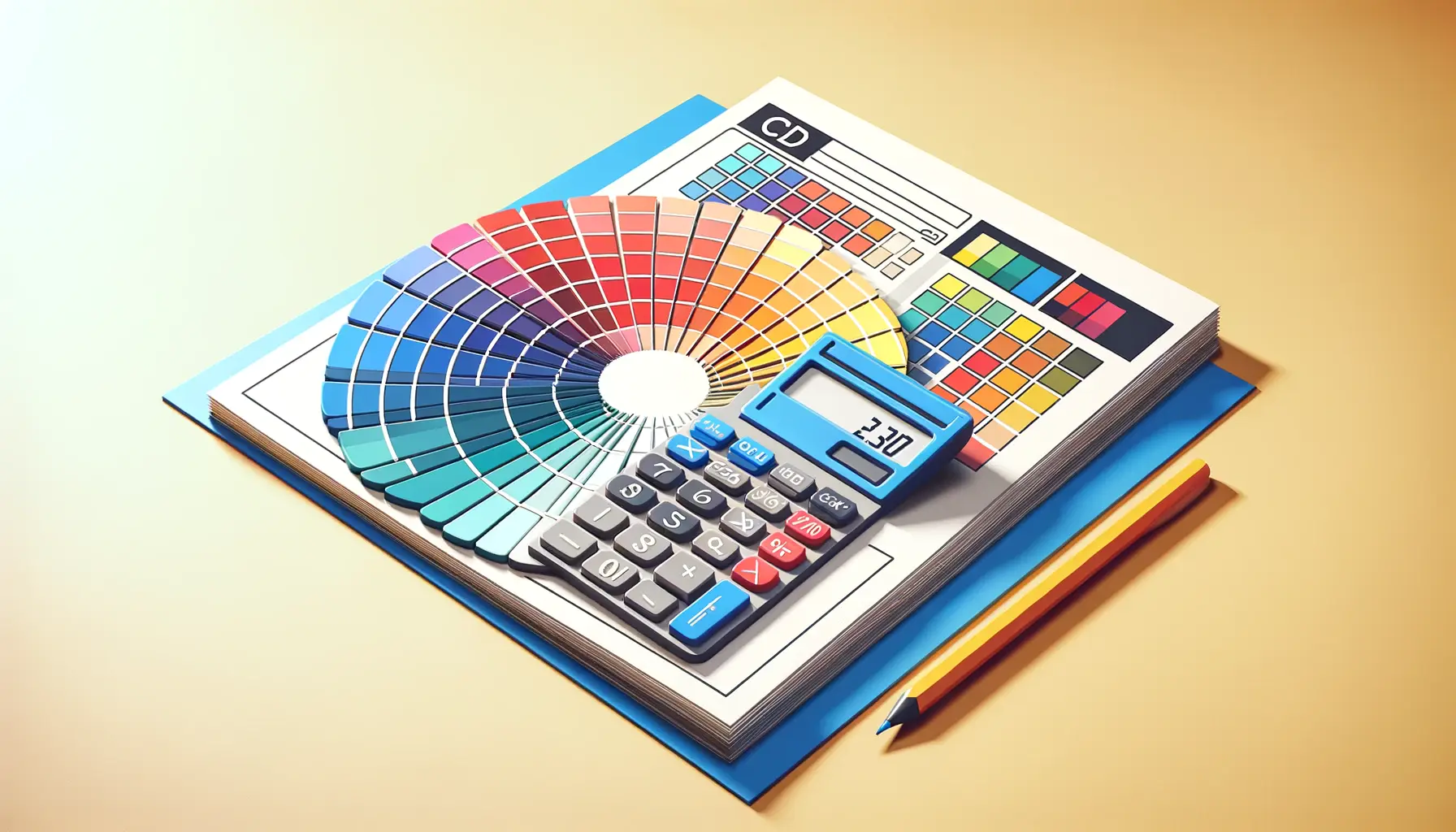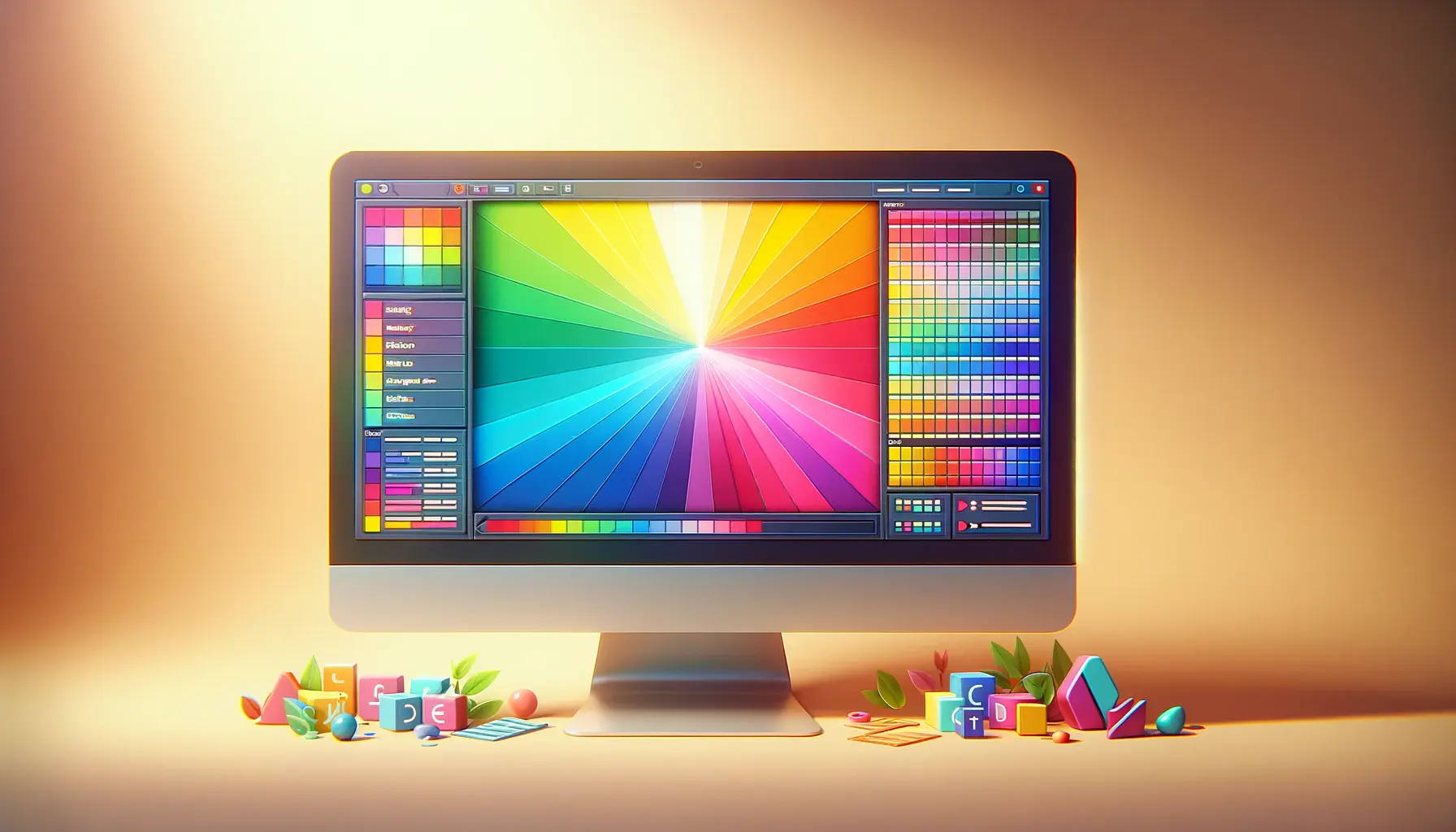The intricate dance between color theory and web design is a fascinating exploration of how aesthetics intersect with functionality.
At the heart of this intersection lies the influence of color theory on website speed and performance, a topic that has garnered attention from web designers and developers alike.
Color theory, a cornerstone of design principles, extends its reach beyond the mere visual appeal, touching upon the very performance of websites.
This relationship, though seemingly abstract, is grounded in the psychological and technical impacts of color choices on user experience and website efficiency.
Understanding the influence of color theory on website speed and performance requires a dive into the psychological effects of colors on user perception and behavior, as well as the technical aspects of web design.
Colors not only convey emotions and messages but also affect the loading times and overall performance of a website.
The strategic use of color can enhance user engagement, reduce bounce rates, and even influence conversion rates.
This article aims to unravel the complexities of color theory in the context of web design, offering insights into how colors can be leveraged to optimize both the aesthetic and functional aspects of websites.
- Introduction to Color Theory in Web Design
- Impact of Color on Website Speed and Performance
- Color Theory and User Interface Design
- Optimizing Web Accessibility Through Color
- Color Psychology in Marketing and Branding
- Future Trends in Color Theory Application
- Integrating Color Theory with Advanced Technologies
- Embracing the Spectrum: The Enduring Influence of Color Theory
- FAQs on the Influence of Color Theory on Website Performance
Introduction to Color Theory in Web Design
Color theory is an essential component of web design, providing a framework for understanding how colors interact with each other and influence the viewer.
It encompasses a range of concepts from color harmony to the psychological effects of colors, guiding designers in creating visually appealing and effective websites.
The choice of colors for a website goes beyond aesthetic considerations, impacting the user’s mood, feelings, and actions while navigating through the site.
The application of color theory in web design is not just about choosing attractive colors; it’s about creating a cohesive and accessible user experience.
Colors can direct attention, evoke emotions, and even affect the perceived usability and speed of a website.
For instance, certain colors can trigger psychological responses that speed up the user’s perception of loading times, while others might contribute to a more relaxed and patient browsing experience.
This psychological interplay between color and perception is a critical consideration for web designers aiming to optimize site performance.
Color Harmony and User Experience
Color harmony refers to the pleasing arrangement of colors that creates balance and aesthetic appeal in design.
In the context of web design, achieving color harmony can significantly enhance the user experience by creating a sense of order and beauty.
This harmony can influence the user’s emotional state, making the website more inviting and easier to navigate.
A harmonious color palette can also improve readability and content hierarchy, guiding the user’s eye through the site in a logical and intuitive manner.
Moreover, color harmony plays a role in brand recognition and consistency.
A well-chosen color scheme that aligns with the brand’s identity can reinforce brand messaging and foster a stronger connection with the audience.
The strategic use of color can differentiate a website from its competitors, making it more memorable and impactful in the user’s mind.
This aspect of color theory underscores the importance of thoughtful color selection in creating a positive and cohesive user experience.
The strategic application of color theory in web design can significantly influence website speed and performance by enhancing user engagement and optimizing visual hierarchy.
Impact of Color on Website Speed and Performance
The influence of color on website speed and performance extends beyond the superficial layer of aesthetic appeal, delving into the realm of user perception and technical efficiency.
While the choice of colors can set the mood and tone of a website, it also plays a crucial role in how quickly a page loads and how smoothly it operates.
This section explores the dual impact of color choices on both the psychological perception of speed and the actual performance metrics of websites.
At first glance, the connection between color and website performance might seem tenuous.
However, the efficiency of a website’s design, including its color scheme, can significantly affect loading times and overall user experience.
Colors not only influence how content is perceived but also how it is delivered and rendered by web browsers.
Psychological Perception of Speed
- User Engagement: Colors that are appealing and engaging can make users feel more patient, reducing their perception of loading times. A vibrant and thoughtfully designed color palette can captivate users, making them less likely to notice minor delays.
- Mood Influence: Certain colors can evoke emotions that influence the user’s perception of time. For example, cool colors like blue and green are often associated with calmness and can make waiting times feel shorter.
Technical Aspects of Color in Web Performance
- Optimization of Assets: The use of color-rich images and graphics can increase the size of web assets, affecting loading times. Optimizing these assets for web use, including proper color management, is crucial for maintaining fast performance.
- Color Scheme Complexity: Websites with simpler color schemes tend to load faster than those with complex arrays of colors. This is because fewer colors mean less data for the browser to process, leading to quicker rendering times.
Understanding the balance between the psychological and technical implications of color on website speed and performance is essential for web designers.
By carefully selecting and optimizing color schemes, designers can enhance both the perceived and actual efficiency of websites, leading to a better user experience and improved performance metrics.
Optimizing color usage is not just about choosing the right shades but also about understanding their impact on both user perception and technical performance.
Color Theory and User Interface Design
Integrating color theory into user interface (UI) design is pivotal for creating effective and engaging digital environments.
The strategic application of color can significantly enhance usability, guide user behavior, and improve the overall aesthetic of a website.
This section delves into how color theory influences UI design, focusing on aspects such as navigation, readability, and emotional engagement.
Colors have the power to communicate function and importance, making them essential tools in the UI designer’s toolkit.
Through careful selection and application, colors can direct users’ attention to key areas, differentiate between types of information, and create a coherent visual hierarchy.
Enhancing Navigation with Color
- Visual Cues: Color can serve as an intuitive guide for users, marking navigation elements clearly and indicating interactive components like buttons and links.
- Consistency: Using a consistent color scheme across the UI helps users recognize patterns and navigate more efficiently, reducing cognitive load and enhancing user experience.
Improving Readability and Accessibility
- Contrast: Adequate contrast between text and background colors is crucial for readability. High contrast makes content more accessible to users with visual impairments, complying with accessibility standards.
- Color Blindness Considerations: Designing with color blindness in mind ensures that information is accessible to a wider audience. Using color combinations that are distinguishable to color-blind users enhances usability.
Fostering Emotional Connections
Colors evoke emotions, and in UI design, leveraging this emotional power can create a more engaging and memorable user experience.
The choice of color palette can reflect the brand’s personality and values, fostering a deeper connection with users.
Warm colors might be used to energize and excite, while cool colors can create a calming and trustworthy atmosphere.
Integrating color theory into UI design not only improves the visual appeal of a website but also its functionality and user experience.
By understanding and applying principles of color harmony, contrast, and psychology, designers can create interfaces that are both beautiful and effective.
The thoughtful application of color theory in UI design can transform user interaction, making it more intuitive, accessible, and emotionally resonant.
Optimizing Web Accessibility Through Color
Web accessibility remains a critical consideration in designing inclusive digital experiences.
Color plays a significant role in ensuring that websites are accessible to all users, including those with visual impairments or color vision deficiencies.
This part of the article explores how color theory can be applied to enhance web accessibility, focusing on aspects such as contrast, color choice, and the use of color to convey information.
Ensuring that your website is accessible to as wide an audience as possible not only broadens your reach but also reflects a commitment to inclusivity.
By adhering to established guidelines and considering the impact of color choices on accessibility, designers can create websites that are both visually appealing and universally usable.
Contrast Ratios for Better Readability
- Guidelines and Standards: Web Content Accessibility Guidelines (WCAG) recommend specific contrast ratios for text and background colors to ensure that content is readable for users with low vision or color vision deficiencies.
- Tools and Techniques: Numerous tools are available to help designers evaluate and adjust the contrast of their color schemes, ensuring compliance with accessibility standards.
Choosing Accessible Color Schemes
- Avoiding Color Reliance: Designers should ensure that information is not conveyed solely through color, as this practice can exclude users who are color blind or have difficulty distinguishing colors.
- Supplementary Indicators: Incorporating symbols, text labels, or patterns alongside color cues can make interfaces more accessible by providing alternative ways to interpret information.
Testing for Color Accessibility
Testing with real users, including those with visual impairments, is invaluable in assessing the accessibility of a color scheme.
Simulators and tools that mimic various forms of color vision deficiencies can also provide insights into how color choices affect usability for affected users.
Optimizing web accessibility through thoughtful color selection and application not only complies with legal and ethical standards but also enhances the user experience for a diverse audience.
By prioritizing accessibility in color theory application, designers can contribute to a more inclusive digital world.
Accessible design is not just a regulatory requirement; it’s a best practice that enhances user experience and broadens your website’s appeal.
Color Psychology in Marketing and Branding
The strategic use of color in marketing and branding is a powerful tool to influence consumer behavior, convey brand identity, and enhance brand recognition.
Color psychology delves into how different hues can affect emotions, perceptions, and actions, making it a critical consideration in creating marketing materials and brand assets.
This section explores the role of color psychology in marketing and branding, highlighting its impact on consumer engagement and brand loyalty.
Understanding the psychological effects of colors can help marketers and designers craft compelling brand messages and create an emotional resonance with their target audience.
The choice of colors for a brand or campaign is not arbitrary; it’s a deliberate strategy that reflects the brand’s personality and values.
Building Brand Identity with Color
- Consistency: Consistent use of a brand’s color palette across all marketing materials and digital platforms helps to reinforce brand identity and improve brand recall among consumers.
- Emotional Appeal: Colors can evoke specific emotions and associations, making them powerful tools to convey the essence of a brand and connect with the audience on an emotional level.
Influencing Consumer Behavior
- Perception of Quality: Certain colors can influence consumers’ perceptions of a product’s quality and value. For example, black is often associated with luxury and sophistication, while green can signify eco-friendliness or health.
- Call to Action: The colors used for call-to-action buttons and links can significantly affect conversion rates. Colors that stand out from the rest of the site, yet are harmonious with the overall design, can draw attention and encourage clicks.
Enhancing Brand Recognition
Color is a key factor in brand recognition.
A distinctive color scheme can make a brand more recognizable and memorable to consumers.
This recognition can enhance consumer loyalty and preference, as familiar brands often evoke a sense of trust and reliability.
Integrating color psychology into marketing and branding strategies enables businesses to craft more effective and emotionally resonant brand messages.
By leveraging the power of color, brands can differentiate themselves in a crowded market, foster emotional connections with their audience, and ultimately drive consumer engagement and loyalty.
Color is not just a visual element but a strategic tool that can significantly influence consumer perceptions and behaviors in marketing and branding.
Future Trends in Color Theory Application
The application of color theory in web design and digital media is an ever-evolving field, with new trends and technologies shaping how colors are used to enhance user experience and engagement.
As we look to the future, several emerging trends promise to influence the application of color theory in innovative ways.
This section explores potential future directions in color theory application, highlighting how these trends could impact web design, branding, and user interaction.
Staying ahead of these trends is crucial for designers and marketers aiming to create compelling, forward-thinking digital experiences.
By understanding and anticipating changes in how color is used and perceived, professionals can leverage color theory to its fullest potential, ensuring their projects remain relevant and engaging.
Personalization and Customization
- User-Centric Design: Advances in technology and data analytics enable more personalized user experiences, including customized color schemes that adapt to individual user preferences or contexts.
- Dynamic Color Systems: Dynamic and adaptive color systems that change based on user interaction, time of day, or other factors are becoming more prevalent, offering a more engaging and responsive user experience.
Accessibility and Inclusivity
- Enhanced Standards: As awareness of accessibility issues grows, the application of color theory will increasingly prioritize inclusivity, ensuring digital content is accessible to all users, including those with visual impairments.
- Innovative Tools: The development of new tools and technologies to test and improve color accessibility will help designers create more inclusive digital environments.
Sustainability and Environmental Consideration
The trend towards sustainability and environmental consciousness is influencing color choices, with a preference for natural and earthy tones that reflect eco-friendly values.
This shift impacts not only design aesthetics but also brand messaging and consumer perception.
The future of color theory application is rich with possibilities, driven by technological advancements, a deeper understanding of user psychology, and a commitment to inclusivity and sustainability.
By embracing these trends, designers and marketers can create more meaningful, engaging, and accessible digital experiences.
Ignoring the evolving trends in color theory application can result in outdated and less effective digital projects.
Integrating Color Theory with Advanced Technologies
The integration of color theory with advanced technologies is revolutionizing the way we approach design and user experience.
As technology evolves, so does the potential for applying color theory in more sophisticated and impactful ways.
This convergence of color science and technology opens up new avenues for creativity, engagement, and interaction in digital media and web design.
From augmented reality (AR) and virtual reality (VR) to artificial intelligence (AI) and machine learning, advanced technologies are providing designers with unprecedented tools to apply color theory in innovative ways.
These technologies not only enhance the visual appeal of digital products but also improve usability, accessibility, and user satisfaction.
Augmented and Virtual Reality
- Immersive Experiences: AR and VR technologies allow for the creation of immersive experiences where color plays a crucial role in realism, mood setting, and user engagement.
- Color Interaction: These technologies enable users to interact with color in dynamic ways, such as changing environments or objects’ colors in real-time, enhancing the interactive experience.
Artificial Intelligence and Machine Learning
- Personalized Color Schemes: AI and machine learning can analyze user preferences and behaviors to suggest or adapt color schemes that enhance personalization and user experience.
- Color Optimization: These technologies can also optimize color choices for accessibility and visibility, ensuring content is accessible to a wider range of users.
Environmental and Contextual Color Adaptation
Emerging technologies enable digital interfaces to adapt their color schemes based on environmental factors, such as ambient light or the user’s physical surroundings, improving readability and comfort.
Similarly, contextual color adaptation can adjust color schemes based on the content being viewed or the user’s task, enhancing focus and efficiency.
The integration of color theory with advanced technologies not only enhances the aesthetic and functional aspects of digital products but also opens up new possibilities for personalized and adaptive user experiences.
As these technologies continue to evolve, the potential for innovative applications of color theory in web design and digital media is bound to expand, offering exciting opportunities for designers and users alike.
Leveraging advanced technologies to apply color theory can lead to more engaging, accessible, and personalized digital experiences.
Embracing the Spectrum: The Enduring Influence of Color Theory
The journey through the realms of color theory and its application in web design, user interface, accessibility, marketing, branding, and emerging technologies underscores the profound influence color holds in the digital age.
This exploration reveals not just the aesthetic value of color but its pivotal role in enhancing functionality, user experience, and emotional engagement.
As we’ve navigated through various facets of color theory, it’s evident that its application extends far beyond mere decoration, embedding itself into the very fabric of digital interaction and communication.
Color Theory: A Bridge Between Art and Science
Color theory represents a unique intersection between art and science, offering a framework that guides the use of color in creating more effective and compelling digital experiences.
The strategic application of color theory in web design and UI development has shown to significantly influence user behavior, facilitate navigation, and improve the readability and accessibility of digital content.
Moreover, the psychological impact of color on users’ emotions and perceptions plays a crucial role in branding and marketing, enabling businesses to convey their message more effectively and connect with their audience on a deeper level.
The Future Painted in Vibrant Hues
Looking ahead, the integration of color theory with advanced technologies such as AR, VR, AI, and machine learning promises to further revolutionize the digital landscape.
These technologies offer new dimensions of interaction and personalization, allowing for dynamic color adaptations that respond to user preferences, environmental conditions, and contextual factors.
The future of color theory application is bright, with endless possibilities for creating more engaging, accessible, and personalized user experiences.
- The importance of color theory in enhancing website speed and performance cannot be overstated, with its influence extending to both the psychological perception of speed and the technical aspects of web performance.
- Accessibility and inclusivity remain at the forefront of color theory application, ensuring that digital content is accessible to all users, including those with visual impairments or color vision deficiencies.
- The role of color in marketing and branding continues to evolve, with color psychology playing a key role in influencing consumer behavior and enhancing brand recognition.
- Emerging trends and technologies are set to expand the application of color theory, offering new ways to engage users and personalize their digital experiences.
In conclusion, the influence of color theory on website speed and performance, user interface design, accessibility, marketing, branding, and the integration with advanced technologies highlights its critical role in the digital domain.
As we move forward, the thoughtful application of color theory will remain a cornerstone in creating meaningful and impactful digital experiences.
By embracing the full spectrum of possibilities that color theory offers, designers, marketers, and technologists can continue to innovate, inspire, and connect with users in ever more profound ways.
Quality web design is key for a great website! Check out our service page to partner with an expert web design agency.
FAQs on the Influence of Color Theory on Website Performance
Explore common questions about how color theory impacts website design and user experience.
Color theory significantly influences web design by affecting user emotions, behaviors, and site usability, enhancing overall engagement and conversions.
While color choices directly impact visual perception and user experience, they indirectly affect perceived website speed by influencing user satisfaction levels.
Color shapes user experience by evoking emotions, guiding navigation, and improving readability, thereby affecting user engagement and retention.
Color psychology can significantly boost website conversions by eliciting specific emotional responses that encourage users to take desired actions.
The best color scheme for a website depends on its brand identity, target audience, and the emotions it aims to evoke, with a focus on accessibility and contrast.
Color contrast is crucial for readability, accessibility, and guiding user focus, making it a key element in effective web design.
Yes, an inappropriate color scheme can negatively impact user experience, reduce engagement, and ultimately affect website performance metrics.
Color theory enhances online brand recognition by using consistent, strategic color schemes that evoke the brand’s values and connect emotionally with the audience.
